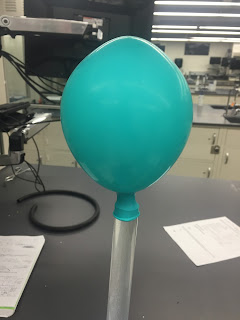 Today was a very bittersweet day in the lab. It was, unfortunately, the very last lab that the probe buddies will ever do together in Chem Honors, CTD, 2k15. However, this is also the first day that Ameera and I ever finished before everyone else, and we actually collected accurate data that was very close to the expected data for once too! We were very proud.
Today was a very bittersweet day in the lab. It was, unfortunately, the very last lab that the probe buddies will ever do together in Chem Honors, CTD, 2k15. However, this is also the first day that Ameera and I ever finished before everyone else, and we actually collected accurate data that was very close to the expected data for once too! We were very proud.
Here is a photo of our burette to the left. As you can see, it is a very long structure that made it beneficial to be so tall, so I could pour our strong base, NaOH, into the top, as you can see to the right. After the initial #basic rinse of the burette, I filled it until there were exactly 50 mL in the long tube. Next, we placed our beaker filled with 8 mL of the acetic acid of vinegar underneath the burette, so it was ready to catch the drops of base as they slowly dripped down. We added around 20 mL of distilled water to the vinegar as well, so that the acid and base reactions would be clearer to see. We added several drops of phenolphthalein (pH) to the flask that would turn pink with each drop until reaching the perfect pale pink color that would indicate the acid and base had reached the equivalence point. We also added a magnetic stirring device that could stir our solution using magnets in the hot plate. Finally, the probe buddies were ready to begin our first trial!
It was painstakingly difficult and very stressful to watch the base NaOH slowly drip into the acetic acid. If even a single drop of base too much were added, the equilibrium reached would disappear and the solution would suddenly became very #basic, as indicated by an extreme dark pink. Unfortunately, we obtained this result from our first trial. Apparently, 25.5 mL of NaOH was just a tad too much. :( So close, so far.
It was painstakingly difficult and very stressful to watch the base NaOH slowly drip into the acetic acid. If even a single drop of base too much were added, the equilibrium reached would disappear and the solution would suddenly became very #basic, as indicated by an extreme dark pink. Unfortunately, we obtained this result from our first trial. Apparently, 25.5 mL of NaOH was just a tad too much. :( So close, so far.
Lucky, Ameera and I were ready to succeed in the second trial! This time, we used 7.5 mL of vinegar, and we added the drops of NaOH more carefully. After much stress and minor screaming, we obtained this beautiful, pale pink of equilibrium! This time, we used exactly 25.6 mL of NaOH, and hit the sweet spot.
We calculated the percent ionization of vinegar as follows....
[H3O^+] / [CH3COOH] x 100 = percent ionization
.00398 / [.83] x 100 = 47.96%
The percent ionization is such a low number because acetic acid is a very weak acid, and weak acids do not ionize fully with strong bases. A stronger acid, like perhaps HCl, would have had a much higher percent ionization. However, even though vinegar is a weak acid, it still has just as much potential to equalize a base.
We calculated the percent ionization of vinegar as follows....
[H3O^+] / [CH3COOH] x 100 = percent ionization
.00398 / [.83] x 100 = 47.96%
The percent ionization is such a low number because acetic acid is a very weak acid, and weak acids do not ionize fully with strong bases. A stronger acid, like perhaps HCl, would have had a much higher percent ionization. However, even though vinegar is a weak acid, it still has just as much potential to equalize a base.
 |
| probe forever |



























